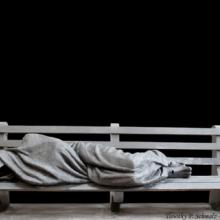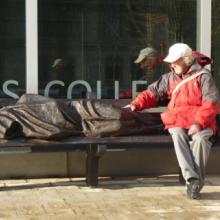sculpture
In a small college town 20 miles north of Charlotte, N.C., “Homeless Jesus” is provoking more conversation than a month of Sunday sermons.
The hollow, bronze piece bolted to the park bench is a $22,000 gift from a church member intended to support public art.
That’s a small price to pay to get people thinking about what it means to be a Christian — and what it means for “Homeless Jesus” to take up residence in a community of 270 townhomes and single-family homes, said the Rev. David Buck, the rector of St. Alban’s.
TORONTO — This homeless Jesus can barely find a home.
Canadian sculptor Timothy Schmalz notes the ironies in his latest creation, “Jesus the Homeless,” a bronze sculpture depicting the Christian savior huddled beneath a blanket on an actual-size park bench. Only the feet are visible, and their gaping nail wounds reveal the subject.
“If Jesus was watching the streets today,” Schmalz says from his home in St. Jacobs, Ontario, “I think he would want himself represented as one of the most marginalized. That’s what he said in the Gospel.”
Indeed, as Schmalz notes, Jesus calls on his followers to clothe the naked, feed the hungry, and tend to the lame. Possibly referring to himself, Jesus says, in the book of Matthew, that “the Son of Man has nowhere to lay his head.”
WHENEVER I entered a museum gallery and saw sculptures by Elizabeth Catlett, I wanted to touch them. The figures were often smooth, glistening, and engaging. They spoke to me in the same manner as the poetry of Langston Hughes and the musical compositions of Duke Ellington.
When Catlett died in April, I was reminded again that she created artwork for celebration and spiritual nourishment. She mastered the ability to bring beauty out of wood and stone.
In many ways Catlett was ahead of her times. During the 1940s she had explored the black woman’s body as a theme for sculpture and paintings. The images she created upheld the strength and dignity of women. The black woman presented as mother could be seen nurturing a child. In work such as “Homage to My Young Black Sisters,” the black woman figure strikes a posture of resistance with a fist raised. The buttocks of the cedar sculpture reflect strength as well as sensuality. One is quickly reminded of young Student Nonviolent Coordinating Committee workers, members of the Black Panther Party, and even activist Angela Davis. “Homage to My Young Black Sisters” was created in 1968, the same year the Summer Olympics in Mexico City saw track stars John Carlos and Tommie Smith raise their fists on the awards stand in a black power salute.
The art of Elizabeth Catlett ignored borders. Although she resided in Mexico, her work reflected the changing consciousness of African Americans in the 1960s and 1970s. The civil rights and black power movements renewed interest in African-American history. The black art movement introduced a desire to define a black aesthetic. Catlett’s work as an elder provided younger artists with a model and a teacher to emulate. In 1969, she created the print “Malcolm X Speaks for Us.” In it we see how she links Malcolm’s face to that of other black faces. The result is a powerful sense of community.
[caption id="attachment_34028" align="alignleft" width="214" caption="Detail of a sculpture at the site of a former slave market, Christ Church, Zanzibar. By Cathleen Falsani."][/caption]

